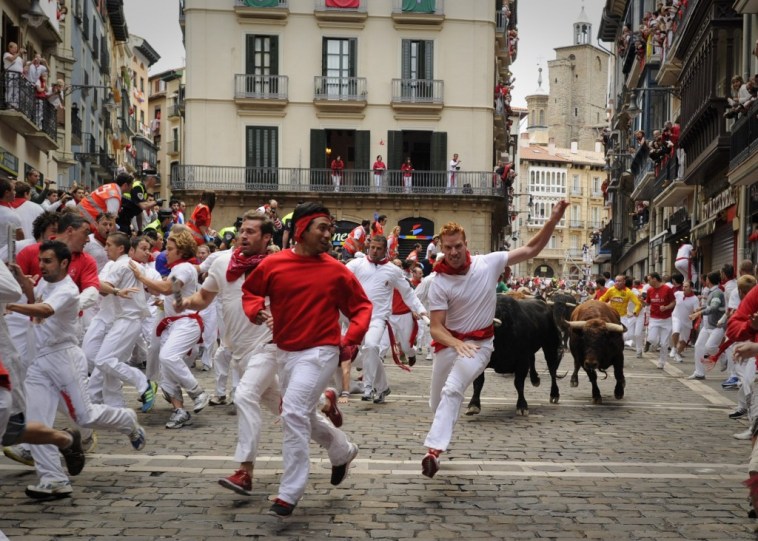ATLANTA – Organizers of a new event planned for several U.S. cities plan to unleash bulls to sprint through fenced-in courses as daredevils try to avoid being trampled.
The Great Bull Run is inspired by the annual running of the bulls in Pamplona, Spain. It’s set to kick off Aug. 24 at a drag-racing strip south of Richmond, Va. A second event is planned for Oct. 19 at an Atlanta-area horse park that hosted events for the 1996 Olympics. More events are planned later for Texas, Florida, California, Minnesota, Illinois and Pennsylvania.
Videos By Rare
‘You can go running down the street anytime you want, but to run with bulls — that’s something that doesn’t come along very often’
– Rob Dickens, co-founder and chief operating officer of The Great Bull Run
Bull runs — when the animals are released to run alongside participants as spectators cheer — are common in Spain and can drum up controversy. Injuries often occur, as do deaths, though they are much rarer. Some groups attack the treatment of the bulls used in the runs.
About 5,000 people have signed up to participate in the Virginia event, and the number grows by about 50 each day, said Rob Dickens, co-founder and chief operating officer of The Great Bull Run. And with 2,000 signed up for the Conyers, Ga., event, Dickens expects 5,000 to 7,000 to run there in October.
The U.S. events will last one day each, unlike the annual weeklong festival in Pamplona, when bull runs are held every morning. Author Ernest Hemingway wrote about the festival in his 1926 novel “The Sun Also Rises,” which helped it gain worldwide notoriety and attract spectators from around the globe.
Organizers acknowledge that the Great Bull Run is likely to start out on a smaller scale than its Spanish counterpart. But they note that other physically challenging activities such as extreme off-road runs and obstacle races have become increasingly popular in the U.S., and they see bull running as a natural follow-up.
“I think it’s just a progression where we are becoming more and more active as a society,” Dickens said. “There’s this fitness craze that started with running. I think this is just an extension of all that, but making it more interesting to the general public.”
Dozens of people are injured each year in the San Fermin festival at Pamplona, most by tripping and falling. Bulls have killed 15 people since record-keeping began in 1924.
Last month in Spain, a University of Utah college student and an Australian woman were gored by bulls. During one run, participants and spectators screamed as a bull tossed a Spaniard to the ground and attacked him, with fellow runners trying to pull the animal away by its tail. The man was eventually dragged to safety.
Organizers of the U.S. events plan to include several safety features, making them “quite different than the running of the bulls in Spain,” Dickens said.
Unlike the narrow, cobblestone streets of the Spanish runs, the U.S. events will use fencing that will include coves, or notches, so participants can get out of the way quickly.
Dickens said organizers are partnering with ranches who will supply the bulls, and veterinarians will monitor their health. “We’re not using the Spanish fighting bulls that are bred to be very aggressive for the entertaining aspect of bullfighting,” Dickens said.
Bulls will be released in waves of six at a time, giving the animals and people a “better opportunity to complete the course safely,” Dickens said.
Before running, participants will be required to sign waivers. Dickens, an attorney, acknowledges that waivers won’t prevent lawsuits but likened it to sky-diving or operating a rock-climbing wall: “The waivers for the most part ensure that even if you get sued, they’re not going to win.”
Researchers are still trying to figure out why some people are drawn to potentially dangerous activities. One theory is that some people get a surge from routine activities, but others need more thrilling or exciting behaviors to get the same feeling, said Dr. Jonathan Becker, assistant professor of clinical psychiatry at the Vanderbilt University School of Medicine.
“To get that same sort of euphoric feeling that you feel at the end of a jog, they may need to jog with bulls for example,” Becker said.
Organizers say they’re planning each of U.S. event as an all-day experience, with plenty of activities such as a tomato fight, also modeled after a Spanish festival. But they hope the bull runs draw participants who have always wanted to participate but couldn’t make the trip to Spain.
“You can go running down the street anytime you want, but to run with bulls — that’s something that doesn’t come along very often,” Dickens said.

